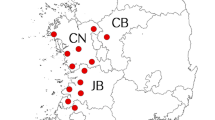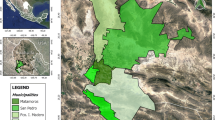Abstract
Zoonotic tick-borne diseases, including those caused by Rickettsia species, continue to have serious consequences for public health worldwide. One such disease that has emerged as a major problem in several countries of the American continent is the Rocky Mountain Spotted Fever (RMSF) caused by the bacterium Rickettsia rickettsii. Several tick species are capable of transmitting R. rickettsia, including Amblyomma cajennense, A. aureolatum, A. imitator, Rhipicephalus sanguineus, Dermacentor andersoni, D. variabilis and possibly A. americanum. Despite previous reports in Mexico linking new outbreaks of RMSF to the presence of these tick species, no robust measures have tackled transmission. In the present study, we amplified R. rickettsii from 109 test DNA samples extracted from ticks collected from several animals and humans of Tamaulipas, Mexico, between November 2015 and December 2017. Our analysis revealed the presence of R. rickettsii in six samples and these findings contribute to a spatial distribution map that is intended to minimize the risk of transmission to humans.


Similar content being viewed by others
References
Alvarez H, Contreras J (2013) Mortality from Rickettsia rickettsii spotted fever in patients at a pediatric hospital in the state of Sonora, 2004–2012. Salud Publica Mex 55(2):151–152
Apperson CS et al (2008) Tick-borne diseases in North Carolina: is "Rickettsia amblyommii" a possible cause of Rickettsiosis reported as Rocky Mountain spotted fever? Vector Borne Zoonotic Dis 8(5):597–606
Arana-Guardia R et al (2015) Ticks (Acari: Ixodidae) from wild mammals in fragmented environments in the south of Yucatán Peninsula México. Southwest Entomol 40(3):656–660
Benavides-Ortiz B, López-Valencia G (2005) Clave pictórica para la identificación de garrapatas en Colombia y norte de Sudamérica. Centro de Investigación en Salud Animal CEISA
Breitschwerdt EB et al (2011) Rickettsia rickettsii transmission by a lone star tick North Carolina. Emerg Infect Dis 17(5):873–875
Burgdorfer W, Hayess SF, Marvos AJ (1981) Nonpathogenic rickettsiae in Dermacentor andersoni: a limiting factor for the distribution of Rickettsia rickettsii. Rickettsiae and Rickettsial diseases. Acadameic Press, Cambridge, pp 585–594
Cage KL, Jerrells TR (1992) Demonstration and partial characterization of antigens of Rickettsia rhipicephali that induce cross-reactive cellular and humoral immune responses to Rickettsia rickettsii. Infect Immun 60(12):5099–5106
Chaudhry M, Scofield R (2013) Atypical Rocky Mountain spotted fever with polyarticular arthritis. Am J Med Sci 346:427–429
Costa FB et al (2017) Rickettsia amblyommatis infecting ticks and exposure of domestic dogs to Rickettsia spp. in an Amazon-Cerrado transition region of northeastern Brazil. PLoS ONE 12(6):1–17
Cruz-Vazquez C, Garcia-Vazquez Z (1999) Seasonal distribution of Rhipicephalus sanguineus ticks (Acari: Ixodidae) on dogs in an urban area of Morelos Mexico. Exp Appl Acarol 23(3):277–280
Dantas-Torres F (2008) The brown dog tick, Rhipicephalus sanguineus (Latreille, 1806) (Acari: Ixodidae): from taxonomy to control. Vet Parasitol 152(3–4):173–185
Dantas-Torres F, Chomel BB, Ontranto D (2012) Corrigendum to ‘Ticks and tick-borne diseases: a One Health perspective’. Trends Parasitol 28(10):437–446
de la Fuente J, Kocan KM, Contreras M (2015) Prevention and control strategies for ticks and pathogen transmission. Rev Sci Tech 34(1):249–264
Eremeeva M et al (2011) Rickettsia rickettsii in Rhipicephalus ticks, Mexicali Mexico. J Med Entomol 48(2):418–421
Esteve-Gassent MD et al (2014) Pathogenic landscape of transboundary zoonotic diseases in the Mexico–US border along the Rio Grande. Front Public Health 2(177):1–23
Faccioli V (2011) Garrapatas (Acari: Ixodidae y Argasidae) de la Colección de Invertebrados del Museo Provincial de Ciencias Naturales Florentino Ameghino, Serie Catálogos No. 25 (available at https://www.museoameghino.gob.ar/archivos/repositorios/126_descarga_86_faccioli_vanesa.pdf)
Galaviz-Silva L, Pérez-Treviño K, Molina-Garza Z (2013) Distribution of ixodid ticks on dogs in Nuevo León, Mexico, and their association with Borrelia burgdorferi sensu lato. Exp Appl Acarol 61(4):491–501
Gleim ER et al (2016) Factors associated with tick bites and pathogen prevalence in ticks parasitizing humans in Georgia, USA. Parasites Vectors 9(125):1–13
Guedes E et al (2005) Detection of Rickettsia rickettsii in the tick Amblyomma cajennense in a new Brazilian spotted fever-endemic area in the state of Minas Gerais Mem Inst Oswaldo Cruz. Mem Inst Oswaldo Cruz 100:841–845
Guzmán-Cornejo C et al (2011) The Amblyomma (Acari: Ixodida: Ixodidae) of Mexico: identification keys, distribution and hosts. Zootaxa 2998:16–38
Harris EK et al (2017) Comparative vertical transmission of Rickettsia by Dermacentor variabilis and Amblyomma maculatum. Ticks Tick Borne Dis 8(4):598–604
Jones K et al (2008) Global trends in emerging infectious diseases. Nature 451:990–994
Nava S et al (2014) Reassessment of the taxonomic status of Amblyomma cajennense with the description of three new species, A. tonelliae n. sp., A. interandinum n. sp. and A. patinoi n. sp., and reinstatement of A. mixtum, and A. sculptum (Ixodida: Ixodidae). Ticks Tick Borne Dis 5(3):252–276
Niebylski ML et al (1997) Rickettsia peacockii sp. nov., a new species infecting wood ticks, Dermacentor andersoni, in western Montana. Int J Syst Bacteriol 47(2):446–452
Nunes ED et al (2015) Rickettsia amblyommii infecting Amblyomma sculptum in endemic spotted fever area from southeastern Brazil. Mem Inst Oswaldo Cruz 110(8):1058–1061
Parola P, Raoult D (2001) Tick-borne bacterial diseases emerging in Europe. Clin Microbiol Infect 7:80–83
Parola P, Labruna M, Raoult D (2009) Tick-borne Rickettsioses in America unanswered questions and emerging diseases. Curr Infect Dis Rep 11(1):40–50
Peniche-Lara G, Jimenez-Delgadillo B, Dzul-Rosado K (2015) Rickettsia rickettsii and Rickettsia felis infection in Rhipicephalus sanguineus ticks and Ctenocephalides felis fleas co-existing in a small city in Yucatan Mexico. J Vector Ecol 40(2):422–424
Sánchez-Montes S et al (2016) First report of "Candidatus Rickettsia amblyommii" in west coast of Mexico. Ticks Tick Borne Dis 7(6):1139–1145
Saraiva D, Soares H, Soares J, Labruna M (2014) Feeding period required by Amblyomma aureolatum ticks for transmission of Rickettsia rickettsii to vertebrate hosts. Emerg Infect Dis 20(9):1504–1510
Soares J, Soares H, Barbieri A, Labruna M (2012) Experimental infection of the tick Amblyomma cajennense, Cayenne tick, with Rickettsia rickettsii, the agent of Rocky Mountain spotted fever. Med Vet Entomol 26(2):139–151
Sosa-Gutierrez CG, Vargas-Sandoval M, Torres J, Gordillo-Pérez G (2016) Tick-borne rickettsial pathogens in questing ticks, removed from humans and animals in Mexico. J Vet Sci 17(3):353–360
Szabó M, Pinte A, Labruna M (2013) Ecology, biology and distribution of spotted-fever tick vectors in Brazil. Front Cell Infect Microbiol 3(27):1–9
Treadwell T et al (2000) Rocky Mountain spotted fever in the United States, 1993–1996. Am J Trop Med Hyg 63:21–26
Wikswo ME et al (2008) Detection and identification of spotted fever group rickettsiae in Dermacentor species from southern California. J Med Entomol 45(3):509–516
Woods C (2013) Rocky Mountain spotted fever in children. Pediatr Clin North Am 60(2):455–470
Zavala-Castro J et al (2006) Fatal human infection with Rickettsia rickettsii, Yucatan Mexico. Emerg Infect Dis 12:672–674
Zavala-Castro J et al (2008) An increase in human cases of spotted fever rickettsiosis in Yucatan, Mexico, involving children. Am J Trop Med Hyg 79(6):907–910
Zeringóta V et al (2016) Molecular detection of Rickettsia rhipicephali and other spotted fever group Rickettsia species in Amblyomma ticks infesting wild birds in the state of Minas Gerais Brazil. Ticks Tick Borne Dis 8(1):81–89
Author information
Authors and Affiliations
Corresponding author
Additional information
Publisher's Note
Springer Nature remains neutral with regard to jurisdictional claims in published maps and institutional affiliations.
Rights and permissions
About this article
Cite this article
Merino, O., De la Cruz, N.I., Martinez, J. et al. Molecular detection of Rickettsia species in ticks collected in the Mexico-USA transboundary region. Exp Appl Acarol 80, 559–567 (2020). https://doi.org/10.1007/s10493-020-00483-5
Received:
Accepted:
Published:
Issue Date:
DOI: https://doi.org/10.1007/s10493-020-00483-5




